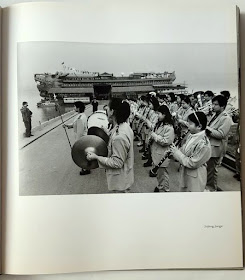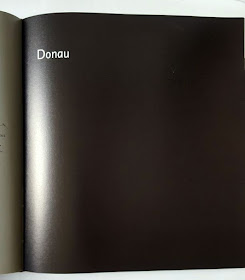 Jazz by Ed van der Elsken ...5B4
Jazz by Ed van der Elsken ...5B4 I know I have already made my favorites list for 2007 but I do want to slip one late arrival in under the wire while we still have a couple days left. Jazz by Ed Van Der Elsken, originally published by De Bezige Bij in Amsterdam in 1959, has just been released in a facsimile edition from Karl Lagerfeld’s Edition 7L in Paris. This is one of several books that Edition 7L has created a facsimile edition of and in each case they have done so with beautiful results.
I know I have already made my favorites list for 2007 but I do want to slip one late arrival in under the wire while we still have a couple days left. Jazz by Ed Van Der Elsken, originally published by De Bezige Bij in Amsterdam in 1959, has just been released in a facsimile edition from Karl Lagerfeld’s Edition 7L in Paris. This is one of several books that Edition 7L has created a facsimile edition of and in each case they have done so with beautiful results.This small book, unassuming from the outside with its 6 ¾ by 7 ¼ inch trim size, reveals itself within the span of just a few pages to be a remarkable document in both photography and book design. Elsken’s small format camera and fast speed film is the perfect combination to catch the spontaneity of what is transpiring both on stage and in the crowd. Within a few frames he shifts our vantage point from passive observers of the musicians to placing us in the shoes and on stage among the players. Jumping from wide shots to extreme close-ups, the strength of the photography is its ability to be as energetic as the music.
 The design, also by Elsken, is another achievement in raising the energy level. The page layouts have their own rhythms and structure that are as metaphorically musical as necessary to create a visual accompaniment that expresses the excitement felt while listening to the music. The book starts with the crowd responding to the first notes and the layout progresses in a fairly traditional way until Miles Davis steps to center stage; Elsken makes a double page spread out of a vertical photo and turns Miles sideways so he defies gravity.
The design, also by Elsken, is another achievement in raising the energy level. The page layouts have their own rhythms and structure that are as metaphorically musical as necessary to create a visual accompaniment that expresses the excitement felt while listening to the music. The book starts with the crowd responding to the first notes and the layout progresses in a fairly traditional way until Miles Davis steps to center stage; Elsken makes a double page spread out of a vertical photo and turns Miles sideways so he defies gravity. Parr and Badger in their citation of this book in Photobook Vol. 1 name William Klein’s New York as a likely influence to the design. I would add that some of Elsken’s page layouts echo the John Hermansader and Reid Miles Blue Note album covers of the late 1950’s with their heavily cropped and contrasty photos of musicians emerging from the darkness. For me, one of the more seductive qualities of the book is how the difference in the coarseness of the film’s grain varies from photo to photo and becomes another element in the design.
Parr and Badger in their citation of this book in Photobook Vol. 1 name William Klein’s New York as a likely influence to the design. I would add that some of Elsken’s page layouts echo the John Hermansader and Reid Miles Blue Note album covers of the late 1950’s with their heavily cropped and contrasty photos of musicians emerging from the darkness. For me, one of the more seductive qualities of the book is how the difference in the coarseness of the film’s grain varies from photo to photo and becomes another element in the design. Few of the images in Jazz escape with their original Leica proportions intact. Elsken crops the images down to their purest form and mostly for the sake of the book’s design. In one particularly creative page, Elsken splices the faces of Coleman Hawkins and Roy Eldridge onto the same head to form a tenor sax and trumpet playing hybrid. The book ends with a sequence of Sarah Vaughn building to a final never-ending note.
Few of the images in Jazz escape with their original Leica proportions intact. Elsken crops the images down to their purest form and mostly for the sake of the book’s design. In one particularly creative page, Elsken splices the faces of Coleman Hawkins and Roy Eldridge onto the same head to form a tenor sax and trumpet playing hybrid. The book ends with a sequence of Sarah Vaughn building to a final never-ending note.The production work on this facsimile edition was done by Steidl. The original was printed in gravure and with this edition; Steidl has accomplished a beautiful faux-gravure printing that is ever so slightly silvery-blue in tone and deeply rich. The paper choice and tack sharp grain of Elsken’s photos complete the feeling of vintage gravure printing.
 The texts by Jan Vrijman, Hugo Claus, Simon Carmiggelt, Friso Endt and Michiel de Ruyter along with a song list of recommended listening appear in their original Dutch. A separate thin-paged booklet of English translations sits in the endpapers.
The texts by Jan Vrijman, Hugo Claus, Simon Carmiggelt, Friso Endt and Michiel de Ruyter along with a song list of recommended listening appear in their original Dutch. A separate thin-paged booklet of English translations sits in the endpapers.The regular edition retails for only $30.00 which I find surprising inexpensive considering the fine quality. There is a special edition of 1000 copies also available for $100.00. This special edition is a facsimile made from an original copy of Jazz from Ed Van Der Elsken’s estate where he had written the names of all of the performers in silver ink directly onto the pages.
Amsterdamse Concertgebouw jazz foto’s ... & see also
Jazz by ...William Claxton, William Klein, Ed van der Elsken


















 Coolpolitics
Coolpolitics

 Ed van der Elsken
Ed van der Elsken 






































































